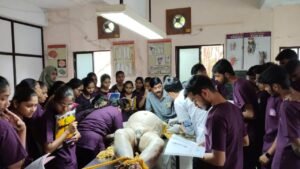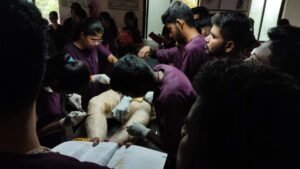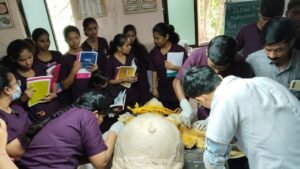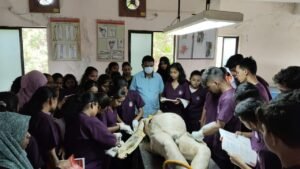Department of Rachana Shareera
OVER VIEW
Anatomy is a branch of medicine that studies the structure of the Human body in Macroscopic & Microscopic and Developmental aspects. This branch specializes in various research aspect specifically genetic research, Cadaveric dissection, Histological study & Tissue processing. Department of Anatomy generates significant contributions to Mission of the College. Department currently has well trained post graduate qualified faculty members with supporting staff












Vision
To develop a benchmark in Rachana Shaeera (Anatomy) education with excellent academic environment where the student can witness true blended learning experience by effective amalgamation of traditional system of Ayurveda and digital teaching learning methods which will help us sustain in the forthcoming digital era.
Mission
Impart Quality medical education with the help of qualified dedicated and motivated teaching faculties by providing excellent academic environment to the undergraduate students to lay the foundation of medical education and research s Inculcate moral and spiritual values to build a clinically and ethically sound Ayurveda doctor
GOAL
The broad goal of the teaching of undergraduate students in anatomy aims at providing comprehensive knowledge of the gross and microscopic structure and development of human body to provide a basis for understanding the clinical correlation of organs or structures involved and the anatomical basis for the disease presentations.
KNOWLEDGE
Comprehend the normal disposition, clinically relevant inter-relationships, functional and cross sectional anatomy of the various structures in the body.
Indentify the microscopic structure and correlate elementary ultra structure of various organs and tissues and correlate the structure with the functions as a prerequisite for understanding the altered state in various disease processes.
Comprehend the basic structure and connections of the central nervous system to analyze the integrative and regulative functions of the organs and systems. He / She shall be able to locate the site of gross lesions according to the deficits encountered.
Demonstrate knowledge of the basic principles and sequential development of the organs and systems; recognize the critical stage of development and the effects of common teratogens.
SKILLS
At the end of the course the student shall be able to: Identify and locate all the structures of the body and mark the topography of the living anatomy.
Identify the organs and tissues under the microscope: Understand the principles of karyotyping and identify the gross congenital anomalies; Understand the principles of newer imaging techniques like Ultra Computerized Tomography Scan Interpretation of Plain and contrast X-rays. sound, (CTS);
Understand clinical basis of some common clinical procedures i.e. intramuscular and intravenous injection, lumbar puncture, kidney biopsy etc.
CORE COMPETENCIES
- Cadaveric dissection
- Histology tissue processing with ordinary and special staining techniques
- Museum specimen preparation
- Video demonstration
- Skill lab to understand the radiological anatomy
TEACHING – LEARNING ACTIVITIES
The Anatomy department facilitates all the learning aspects of the Morphological science in the first year of curriculum.
Well qualified faculty members are teaching the Gross Anatomy, Microscopic Anatomy or Histology, Developmental Anatomy, Radiology surface marking and Osteology..
The Anatomy department trains the students by using both traditional & innovative teaching methods.
The Anatomy department actively takes part in adopting newer teaching methods like small group discussion, problem based learning, demonstration and student seminar and integrated teaching.
The traditional lecture classes enhanced by the advance technologies like computer aided smart board and audio visual aids.
The Anatomy department trains Under Graduate Medical Students.
ASSESSMENT
Periodic formative assessment tests conducted by the department of Anatomy. It includes three terminal examination and model exam. Code number used to be given for each assessment test to avoid bias. Summative assessment conducted by VMRF University at the end of the first year.
CARE FOR SLOW LEARNERS/ BRIDGE COURSE
After the first terminal assessment poor performers & slow learners were identified & counselling given. For them special arrangements, to improve their performance, were also made.
The following teaching learning methods were adopted
1.Small group discussion
2.Video aided learning supported by discussion
3.Demonstration with specimens &slides.
MENTORSHIP PROGRAMME
All faculty were assigned by Institute to do mentorship for 10 student. Apart form general mentor programme,
Small group 10 of students were given in a care of each staff member who analysis individual students, short coming and provided counselling regarding their performance of Anatomy.
